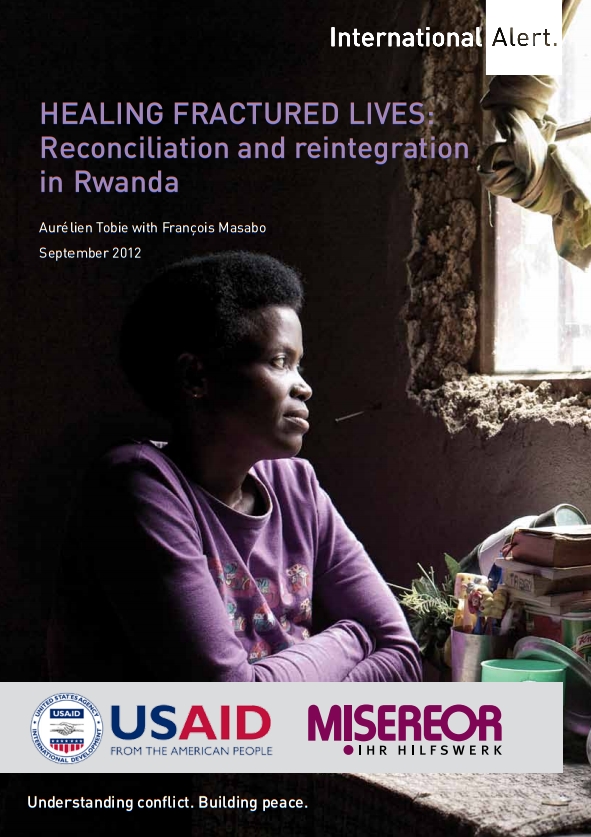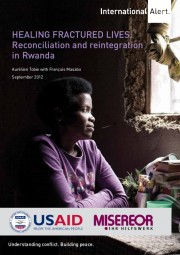
The issue of reparative justice, reconciliation and reintegration.
From: Healing Fractured Lives: Reconciliation and reintegration in Rwanda by Aurélien Tobie with François Masabo for International Alert (September 2012).
Justice is by far the most contentious issue within the reintegration context. It is both a conceptual problem (of who is morally entitled to be helped) and a practical one (e.g. the payment of reparations ordered by Gacaca for level 3 offenders). These issues are strongly felt by beneficiaries of reintegration programmes and implementing organisations alike, as it is one of the main obstacles to the successful cohabitation of ex-prisoners and genocide survivors.
A number of problems are emerging in Rwanda in relation to justice. The Gacaca process is now closed, and fears exist that some cases will not be addressed through more formal justice processes, that the totality of the crimes committed during the genocide have not yet been judged, and that some cases will remain unsolved. Moreover, the implementation of the decisions given by Gacaca has been problematic in itself: for some crimes, for example theft or destruction of property, material reparations have to be paid by the perpetrators. In many instances the perpetrators either refuse or are unable to pay. In effect, poverty is an obstacle to the payment of reparations, and as a consequence, an obstacle to justice and reconciliation.
There is a strong link between reintegration and the themes of justice and reconciliation. However, this causality is linked to very different narratives, depending on the organisations interviewed. For some, justice, and the payment of reparations, is a prerequisite to reintegration. Without the acknowledgement of guilt by the perpetrators, the payment of reparations and the forgiveness of victims, there cannot be social cohesion in Rwanda. Indeed, while reconciliation can be understood as a process, the reparative justice element of reconciliation (the payment of Gacaca reparations) is a trigger for this process. Without this payment, the process is flawed. Therefore, the Gacaca process and the implementation of the decisions taken by the Gacaca courts are a first step towards reconciliation, without which reintegration is impossible.
Another view is that people affected by conflict can only start the process of reconciliation once their basic needs are met. They should feel secure, and have access to ways of fulfilling their demands in terms of livelihood, shelter or health before they can participate in dialogue about the genocide, recognise wrongs and attempt to put them right. A certain level of financial stability would ease the process of justice and the payment of reparations. If perpetrators had the financial means to pay back their dues, and felt physically secure in their communities, they would be more able and willing to fulfil the obligations set by Gacaca. Therefore, justice and reconciliation are seen more as a process than a fixed point in time or as a step which needs to be completed before reintegration can begin. Justice, reconciliation and reintegration are linked, and programmes should seek to implement them together, rather than sequentially.
Both of these theories of change are valid, and it is difficult to validate one and not the other. What remains is a practical, problematic situation with regards to justice and reintegration.
For many reintegration programmes, the issue of reparations remains problematic, particularly for ex-prisoners. Different approaches have been tried to solve the problem, such as mediation between prisoners and survivors to lower the amount of compensation to a realistic level, a proposal for a “community reparation fund”, a national reparation fund (but the law was never passed, and probably never will be), or even just forgetting the debt.
In general, more research needs to be carried out into the issue of reparative justice and its links to the wider situation in Rwanda. There are different terms/concepts/practices which need to be investigated and clarified. In communities, it was not clear during this research what, for example, was understood by “pardon”. Testimonies seemed to link it strongly with the payment of reparations, rather than the moral pardon for the crime committed. Indeed, victims’ accounts of what they meant by “pardon” were often related to the payment of reparations, suggesting you could grant your “pardon” for a lower amount than the one decided by Gacaca. It would, therefore, seem to be very important for people to link moral forgiveness to some degree of material compensation.

